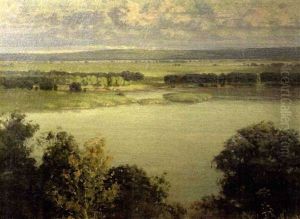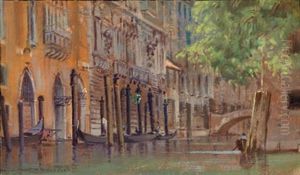Frederick Oakes Sylvester Paintings
Frederick Oakes Sylvester was an American artist known for his atmospheric landscapes and cityscapes, particularly of the Mississippi River and the city of St. Louis. Born on November 8, 1869, in Brockton, Massachusetts, Sylvester showed an early inclination towards the arts, which led him to pursue a career as a painter.
His education in art began at the Massachusetts Normal Art School in Boston. Further honing his skills, he studied for a brief period at the Académie Julian in Paris, which was a popular institution among American and international artists in the late 19th century. Despite the influence of the European art scene, Sylvester's style remained uniquely his own, with a focus on capturing the mood and spirit of the American landscape.
Sylvester moved to St. Louis, Missouri, where he became a prominent figure in the local art community. His paintings often depicted the Mississippi River, which he believed was a deeply symbolic and historically significant American subject. Sylvester's work is characterized by a poetic and often contemplative approach to landscape painting, with a keen attention to the play of light and atmosphere. He was also interested in the urban landscape of St. Louis, and his paintings provide a unique historical record of the city at the turn of the 20th century.
Throughout his career, Sylvester was an active member of the St. Louis art scene. He taught at the St. Louis School of Fine Arts at Washington University and served as a mentor to many young artists. His influence extended beyond his own work, as he played a significant role in the development of the arts in the Midwest.
Frederick Oakes Sylvester's career was cut short by his untimely death on June 15, 1915, at the age of 45. Despite his relatively brief career, his contribution to American art was significant, particularly in the context of Midwestern art history. His paintings are held in the collections of various institutions and continue to be appreciated for their beauty and historical value.





















